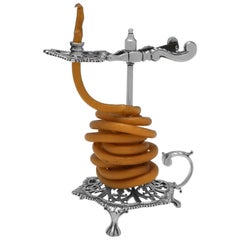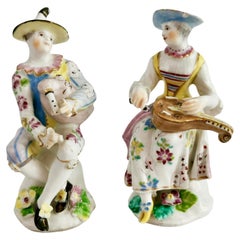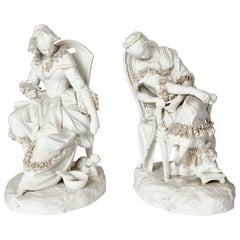Rococo Decorative Objects
Rococo was an aesthetic movement in the fine and decorative arts in the 18th century that found its inspiration in nature and fostered an overall lightness and delicacy of form, construction and ornament in interior design. Rococo furniture, while greatly influenced by trends in Italy and Germany, is often called Louis XV style — the movement having reached its best expression during that sybaritic French king’s reign.
The term “rococo” is thought to be a portmanteau of the French words rocaille and coquilles — “rock” and “shells” — organic motifs frequently used in architecture and design of the style.
When it comes to authentic Rococo furniture's characteristics, it is above all sensuous and social. The furniture of earlier eras in Europe had been heavy in every sense; the Rococo period saw the appearance of light-framed upholstered armchairs, side chairs and occasional tables that could easily be moved to form conversational circles.
The signal detail of Rococo furniture design is the gently curved cabriole, or S-shaped chair-, table-, and cabinet-leg. It imitates the bend of a tree limb or a flower stem. In a further reference to nature, furnishings were often asymmetrical and painted white, or in soft, pastel shades. Rococo has become a timeless style, and as the furniture pieces presented on 1stDibs demonstrate, its playful, sculptural forms can provide visual excitement to contemporary, clean-lined spaces.
1760s English Antique Rococo Decorative Objects
Sterling Silver
1770s Italian Antique Rococo Decorative Objects
Maiolica
1850s German Antique Rococo Decorative Objects
Porcelain
17th Century French Antique Rococo Decorative Objects
Wood
1750s English Antique Rococo Decorative Objects
Porcelain
Late 19th Century French Antique Rococo Decorative Objects
Porcelain
Late 18th Century Dutch Antique Rococo Decorative Objects
Delft
Late 20th Century Rococo Decorative Objects
Brass
Early 19th Century Swedish Antique Rococo Decorative Objects
Pine
19th Century French Antique Rococo Decorative Objects
Bronze
19th Century French Antique Rococo Decorative Objects
Ormolu
18th Century Chilean Antique Rococo Decorative Objects
Iron
Mid-19th Century German Antique Rococo Decorative Objects
Porcelain
Late 19th Century French Antique Rococo Decorative Objects
Ormolu, Bronze
Early 20th Century Italian Rococo Decorative Objects
Porcelain
1880s German Antique Rococo Decorative Objects
Porcelain
1770s Italian Antique Rococo Decorative Objects
Maiolica
17th Century Italian Antique Rococo Decorative Objects
Quartz, Agate, Rock Crystal, Coral
18th Century French Antique Rococo Decorative Objects
Maiolica, Faience, Pottery, Porcelain
17th Century Italian Antique Rococo Decorative Objects
Agate, Rock Crystal, Coral
Early 19th Century English Antique Rococo Decorative Objects
Silver, Silver Plate, Copper
Early 20th Century Unknown Rococo Decorative Objects
Porcelain
1970s German Vintage Rococo Decorative Objects
Porcelain
Early 19th Century French Antique Rococo Decorative Objects
Ebony
Late 19th Century French Antique Rococo Decorative Objects
Bronze
1850s European Antique Rococo Decorative Objects
Bronze
Late 19th Century French Antique Rococo Decorative Objects
Bronze
18th Century German Antique Rococo Decorative Objects
Porcelain
19th Century French Antique Rococo Decorative Objects
Stone, Bronze
1920s Italian Vintage Rococo Decorative Objects
Glass
Mid-18th Century Dutch Antique Rococo Decorative Objects
Delft
Mid-18th Century French Antique Rococo Decorative Objects
Porcelain
1890s German Antique Rococo Decorative Objects
Porcelain
Early 20th Century French Rococo Decorative Objects
Majolica, Porcelain
Mid-18th Century English Antique Rococo Decorative Objects
Porcelain
19th Century French Antique Rococo Decorative Objects
Bronze
Early 19th Century Swedish Antique Rococo Decorative Objects
Pine
18th Century Italian Antique Rococo Decorative Objects
Wood
Mid-19th Century German Antique Rococo Decorative Objects
Porcelain
Early 20th Century Italian Rococo Decorative Objects
Metal, Gold
18th Century Italian Antique Rococo Decorative Objects
Tourmaline, Quartz, Rock Crystal, Gold Leaf
20th Century French Rococo Decorative Objects
Porcelain
19th Century French Antique Rococo Decorative Objects
Bronze, Ormolu
17th Century Italian Antique Rococo Decorative Objects
Coral
17th Century Italian Antique Rococo Decorative Objects
Rock Crystal, Gold Leaf, Gold Plate
Early 19th Century French Antique Rococo Decorative Objects
Marble, Bronze
Late 20th Century American Rococo Decorative Objects
Gold Leaf
17th Century Italian Antique Rococo Decorative Objects
Tourmaline, Rock Crystal
Mid-18th Century English Antique Rococo Decorative Objects
Delft
Late 19th Century French Antique Rococo Decorative Objects
Bronze
17th Century Italian Antique Rococo Decorative Objects
Rock Crystal
17th Century Italian Antique Rococo Decorative Objects
Rock Crystal
18th Century Italian Antique Rococo Decorative Objects
Rock Crystal, Copper
Late 19th Century French Antique Rococo Decorative Objects
Ormolu
Early 1900s French Antique Rococo Decorative Objects
Ceramic
Early 20th Century English Rococo Decorative Objects
Silver Plate
19th Century French Antique Rococo Decorative Objects
Faience
17th Century Italian Antique Rococo Decorative Objects
Rock Crystal




